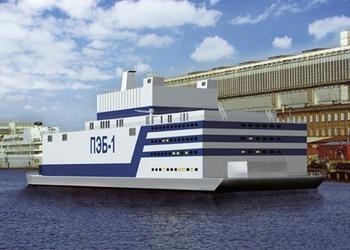
By John C.K. Daly
ST. PETERSBURG, Russia, July 17, 2013 (ENS) – So much for the lessons of Fukushima. Never mind oil spills, the Russian Federation is preparing an energy initiative that, if it has problems, will inject nuclear material into the maritime environment.
The Russian Federation’s first floating nuclear power plant “should be operational by 2016,” Baltiskii Zavod shipyard General Director Aleksandr Voznesenskii told reporters earlier this month at the 6th International Naval Show in St. Petersburg, where the shipbuilding complex is located.

According to Voznesenskii, the “Academician Lomonosov” FNPP will be the first vessel belonging to the new line of floating nuclear power plants that can provide energy, heat and water to remote and arid areas of the country. Mass production of similar floating nuclear power plants is scheduled for the near future.
The “Academician Lomonosov’s” technology is based on the USSR’s construction of nuclear-powered icebreakers.
The Russian media is speculating that the floating nuclear power plants will first be used in remote areas of the northeastern Arctic Russia and the Far East, as these regions currently suffer from a lack of energy, slowing their development.
Each 21,000 ton vessel will have two “modified KLT-40 naval propulsion reactors” that will provide up to 70 megawatts of electricity or 300 megawatts of heat, sufficient for a city with a population of 200,000 people.
Additionally, the floating nuclear power plants can provide water desalination services capable of supplying up to 240,000 cubic meters of fresh water per day.
Those with historical memories will recall accidents with a Soviet-era nuclear icebreaker that released radioactivity into the environment.
Launched in 1957, the “Lenin,” the USSR’s first nuclear powered icebreaker, was powered by three OK-150 reactors. In February 1965, there was a loss of coolant incident, and some of the fuel elements melted or deformed inside reactor number two. The debris was removed and stored for two years, and subsequently dumped in Tsivolki Bay near Novaia Zemlia.
The second accident was a cooling system leak, which occurred in 1967, shortly after refueling.
Not a reassuring development for the Soviet Arctic environment.
“Academician Lomonosov’s” keel was laid in April 2007 at the Sevmash shipyard in Severodvinsk on the White Sea, but the project was later transferred to the Baltiskii Zavod shipyard.
The 21,500 ton hull of the “Academician Lomonosov” was launched in 2010, although construction work was frozen in mid-2011 because of bankruptcy proceedings against the shipyard.
The company was acquired by state-owned United Shipbuilding Corporation and Rosenergoatom, thenuclear power station operations subsidiary of Atomenergoprom, a holding company for all Russian civil nuclear industry, signed a new contract with the Baltiskii Zavod shipyard for completion of the “Academician Lomonosov.”
The vessel is equipped with two modified KLT-40 reactors but has no engines, so it needs to be towed into place. The floating nuclear power stations are to be mass-built at shipbuilding facilities and then towed to a destination point in coastal waters near a city, town or industrial enterprise
The Baltiskii Zavod shipyard stresses that The “Academician Lomonosov” and its successors are all designed with a safety margin exceeding all possible threats, which makes their nuclear reactors invulnerable to tsunamis and other natural disasters. They shipyard claims the ships meet all the requirements of the International Atomic Energy Agency and do not pose a threat to the environment.
The shipyard states that 15 nations, including China, Indonesia, Malaysia, Algeria, Namibia and Argentina have expressed interest in buying floating nuclear power plants.
The “Academician Lomonosov” will be sent to Vilyuchinsk, Kamchatka for operational testing. Rosatom then aims to construct seven more FNPPs by 2015, with four of them likely to be located on the northern coast of Siberia’s Yakutia.
Other Arctic areas provisionally scheduled to receive FNPPs include port cities along the Russian Federation’s arctic coastal Northern Sea Route and Pevek in Chukotka.
An added benefit of the FNPP as envisaged in Moscow is that the provision of nuclear power to the Arctic and Far East will free up more oil and natural gas for foreign export, allowing the Russian Federation to generate additional hard currency.
But tow cables snap, Arctic conditions can be unpredictable, ships sink. As the ocean is the common heritage of humanity, perhaps the international community might evince more interest in this project.
{John C.K. Daly writes for Oilprice.com, where a version of this article was originally published. Used with permission.}
Copyright Environment News Service (ENS) 2013. All rights reserved.
